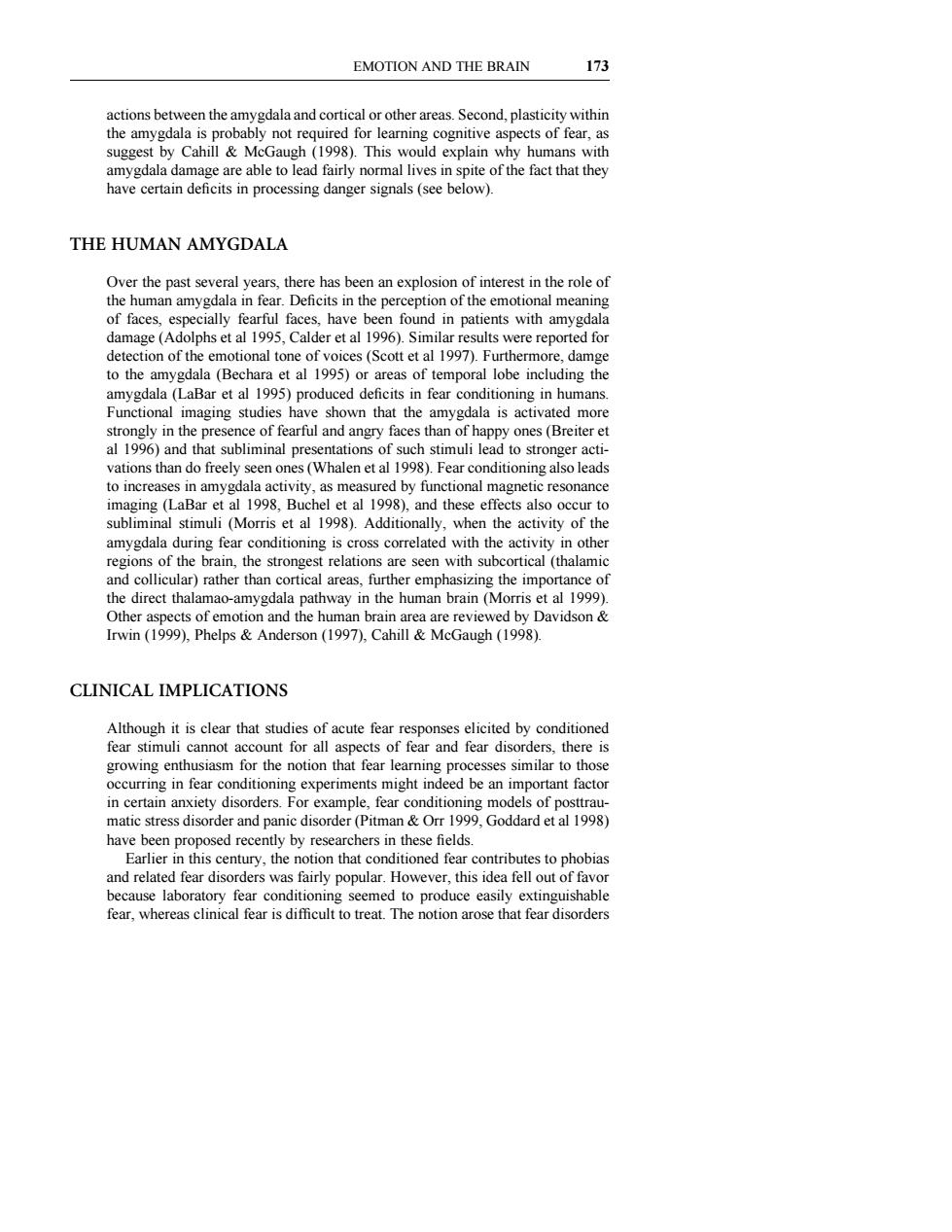正在加载图片...

EMOTION AND THE BRAIN 173 actions between the amygdala and cortical or other areas.Second,plasticity within the amygda 《 roabotTqug9g amvgdala damage are able to lead fairly normal lives in spite of the fact that they have certain deficits in processing danger signals(see below). THE HUMAN AMYGDALA n I e perceptionof detection of the emotional tone of voices(997).Furthermore,damge to the reas of tempora ing the oal ima strongly in the pre nce of fearful and angry faces than of happy ones(Breiter et a suba presentations of such stimuli lead to stronge ons than d h imaging (LaBar et al 199.Buchel et al 998).and these effects also occur to subliminal stimuli (Morris et al 1998).Additionally,when the activity of the amygdala d during fear is cross correlated with the activity in othe e see ng the in the direct thalamao-amygdala pathway in the human brain (Morris et al 1999) (r(( 9).Phelps CLINICAL IMPLICATIONS fear stimuli ot a growing enthusiasm for the notion that fear leaming processes similar to those occurring in fear c nditioning experiments might in d be an important factor have been proposed recently by researchers in these fields Earlier in this century,the notion that conditioned fear contributes to phobias and related fear diso ers wa s fairly popular.However,this idea fell out of fav EMOTION AND THE BRAIN 173 actions between the amygdala and cortical or other areas. Second, plasticity within the amygdala is probably not required for learning cognitive aspects of fear, as suggest by Cahill & McGaugh (1998). This would explain why humans with amygdala damage are able to lead fairly normal lives in spite of the fact that they have certain deficits in processing danger signals (see below). THE HUMAN AMYGDALA Over the past several years, there has been an explosion of interest in the role of the human amygdala in fear. Deficits in the perception of the emotional meaning of faces, especially fearful faces, have been found in patients with amygdala damage (Adolphs et al 1995, Calder et al 1996). Similar results were reported for detection of the emotional tone of voices (Scott et al 1997). Furthermore, damge to the amygdala (Bechara et al 1995) or areas of temporal lobe including the amygdala (LaBar et al 1995) produced deficits in fear conditioning in humans. Functional imaging studies have shown that the amygdala is activated more strongly in the presence of fearful and angry faces than of happy ones (Breiter et al 1996) and that subliminal presentations of such stimuli lead to stronger activations than do freely seen ones (Whalen et al 1998). Fear conditioning also leads to increases in amygdala activity, as measured by functional magnetic resonance imaging (LaBar et al 1998, Buchel et al 1998), and these effects also occur to subliminal stimuli (Morris et al 1998). Additionally, when the activity of the amygdala during fear conditioning is cross correlated with the activity in other regions of the brain, the strongest relations are seen with subcortical (thalamic and collicular) rather than cortical areas, further emphasizing the importance of the direct thalamao-amygdala pathway in the human brain (Morris et al 1999). Other aspects of emotion and the human brain area are reviewed by Davidson & Irwin (1999), Phelps & Anderson (1997), Cahill & McGaugh (1998). CLINICAL IMPLICATIONS Although it is clear that studies of acute fear responses elicited by conditioned fear stimuli cannot account for all aspects of fear and fear disorders, there is growing enthusiasm for the notion that fear learning processes similar to those occurring in fear conditioning experiments might indeed be an important factor in certain anxiety disorders. For example, fear conditioning models of posttraumatic stress disorder and panic disorder (Pitman & Orr 1999, Goddard et al 1998) have been proposed recently by researchers in these fields. Earlier in this century, the notion that conditioned fear contributes to phobias and related fear disorders was fairly popular. However, this idea fell out of favor because laboratory fear conditioning seemed to produce easily extinguishable fear, whereas clinical fear is difficult to treat. The notion arose that fear disorders